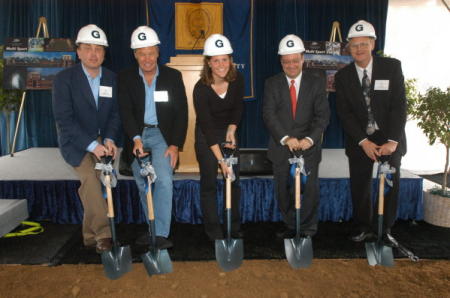Some thoughts following Georgetown 's
17-3 win over Brown Saturday:
1. Good Timing: One could not have asked for a better
afternoon in September for four generations of alumni to return and celebrate
fifty years of modern Georgetown
football. The tailgate, the halftime presentation, the awards dinner, and yes,
the game itself, were shining examples
of what Alumni Association Executive Director Bill Reynolds (C'79) would call
"the best of Georgetown ".
It was also a great opportunity for older alumni to meet
head coach Rob Sgarlata,. Granted, he's been a part of the program for nearly
half of the modern era, but getting visibility to an older cohort of alumni,
the alumni that can exercise powers of persuasion and financial wherewithal was
vital. Sgarlata is not Bob Benson, nor is he Kevin Kelly. He's a different man, one whose sincerity and
focus on the well being of the students under his care is heartfelt and deeply
rooted. Coaching is in his roots, and he takes the responsibility very
seriously.
Amidst all the discussions, talk about scholarships was
largely muted. Saturday's game and dinner was more about the past than the
future. There may come a time to rally the alumni, but in the end it's the
university that has to figure out what it wants out of its alumni and its
program. Like then unfinished field that debuted nine years ago this past
weekend, it's not clear if Georgetown
understands the road it needs to be on. As a former Providence Journal writer
once wrote about Georgetown
basketball in the 1960's, the school
wanted to have a good basketball team but had no sense in how to go about doing
it.
Make no mistake, Georgetown
wants a winning football team. How it goes about doing that seems a arduous and
unnecessarily elongated task. If Sir Winston Churchill were around, he might
say that "I cannot forecast to you the actions of Georgetown . It is a riddle, wrapped in a
mystery, inside an enigma; but perhaps there is a key. That key is Georgetown 's institutional interest."
Coach Sgarlata enjoined the younger alumni in Saturday's
dinner to be there when the program celebrates its 100th such anniversary in
2064. Of course, waiting for the future is no way to prepare for it.
2. The Perils Of Youth: Brian had clobbered Georgetown in each of its four previous
meetings, and not be insignificant numbers. In the first halves of the prior
four games, the bears owned a combined score of
81-17. So what changed?
Two false start penalties in the first two series were a sign
of a team that, for all its practices and pre-season scrimmaging, still needed
time to adjust in a real game. In most seasons, a warm-up against Georgetown would be an
easy task for a veteran team, but the Bears were anything but. Mistakes and
missed opportunities (two red zone possessions in the first half, netting three
points) combined with four turnovers to wear down the hopes of the Bears, and
youth was not served when Georgetown caught fire defensively in the second
half, giving its beleaguered offense an opportunity to step up. This was 17-3,
not 37-3, and the Hoyas' offense won't win many games thereafter this season on
17 points.
We'll learn a lot more
about both teams this week when Georgetown
travels to Colgate and Brown hosts Harvard as part of the school's 250th
anniversary weekend. If Saturday's game is any indication, Brown has a long
weekend ahead of it against a Harvard starting lineup as good as any in the
East.
3. One To Watch: When Matt MacZura graduated in 2014, Georgetown lost one of
its most consistent punters. His successor has been a strong entrant thus far.
Through just three games, Harry McCollum is averaging 43.8 yards per punt,
which would put him third all time at Georgetown
for punt average...as a freshman. of his 25 punts to date, six have landed
inside the opponent 20 and six have been for more than 50 yards.
4. Future Schedules: This is the last game on the calendar
between the schools for the foreseeable future, with brown moving to a series
with neighboring Bryant and Georgetown having signed deals with Columbia, Harvard,
and Princeton for the first three weeks of the Ivy season through at last 2017.
Brown represents the kind of program Georgetown could emulate, however. The Bears
don't have the financial punch of most Ivy teams and no one will confuse Brown
Stadium with the Yale Bowl, but the school recruits well, is fundamentally
sound on and off the field, has continuity
in the coaching staff and is competitive in the standings. That's not a bad
combination at this level, and one to think about as Georgetown enters an
uncertain time in its journey through college football.


